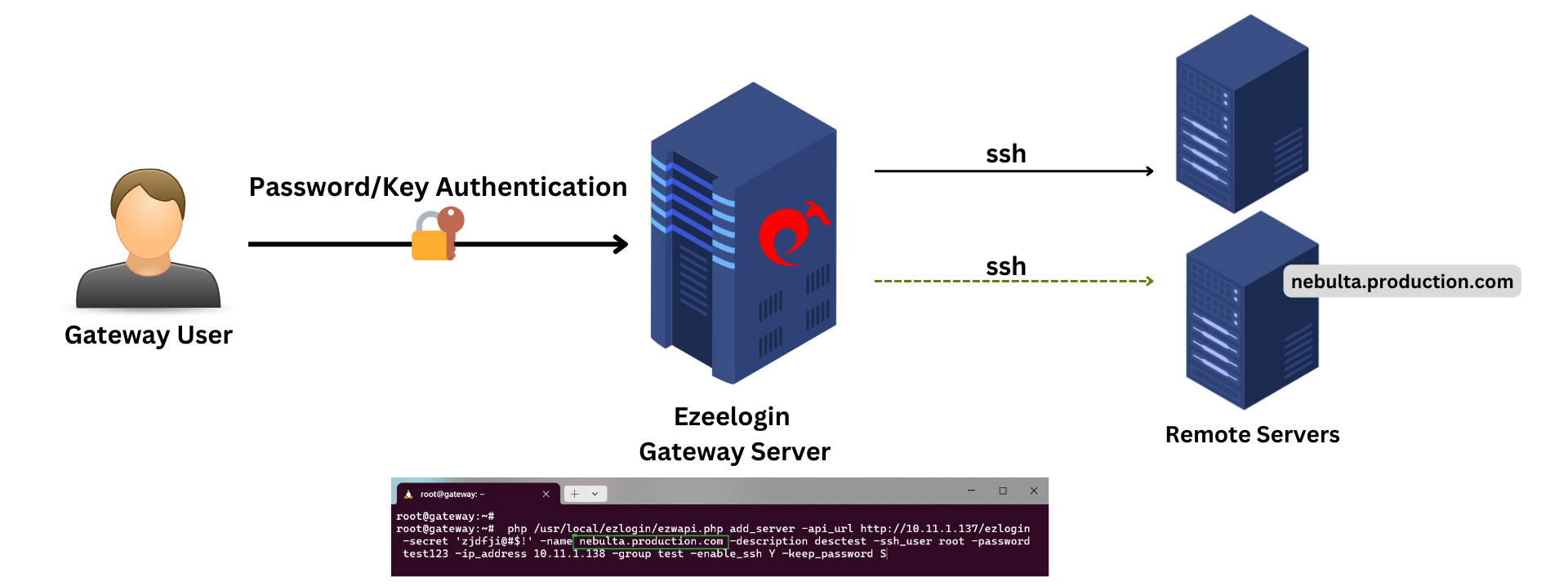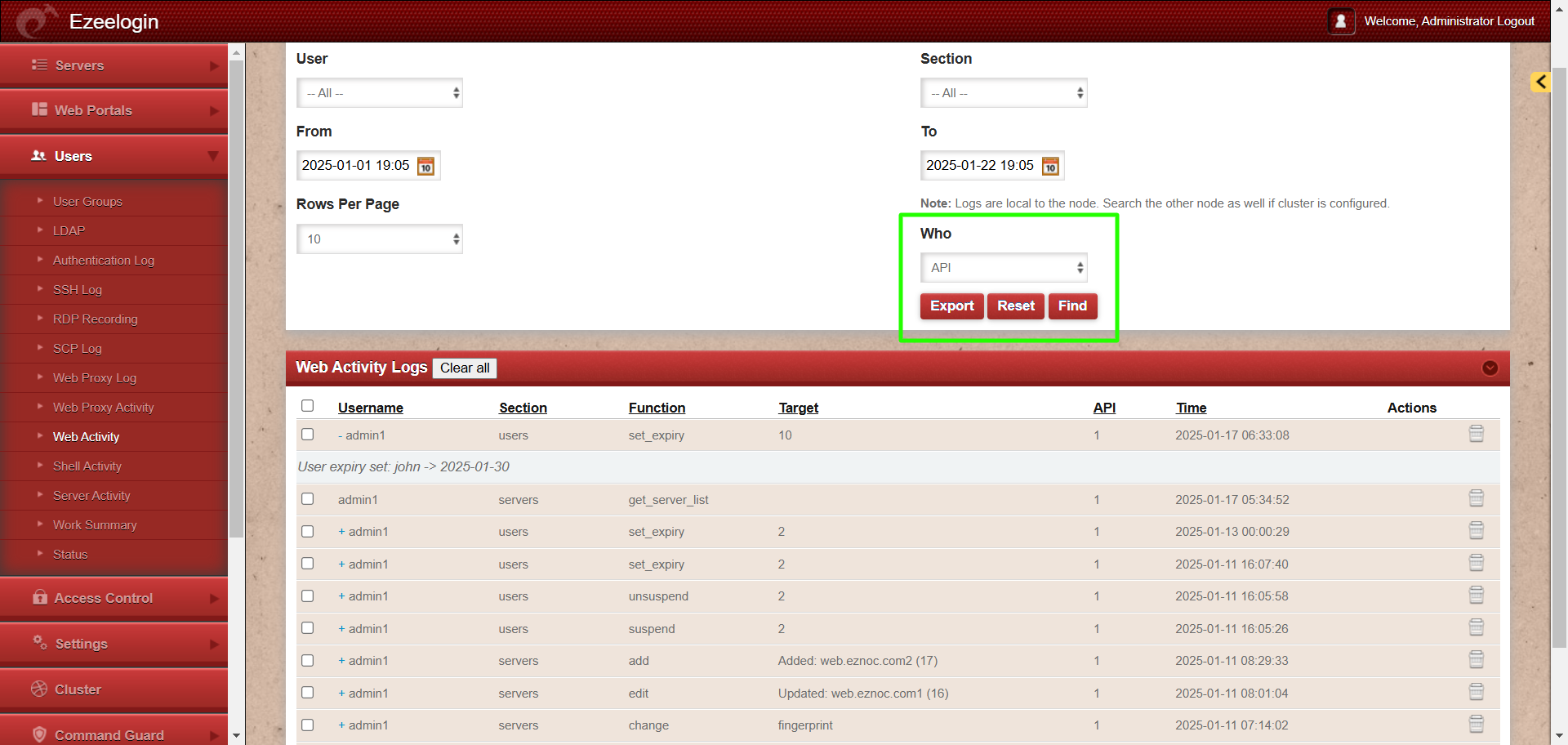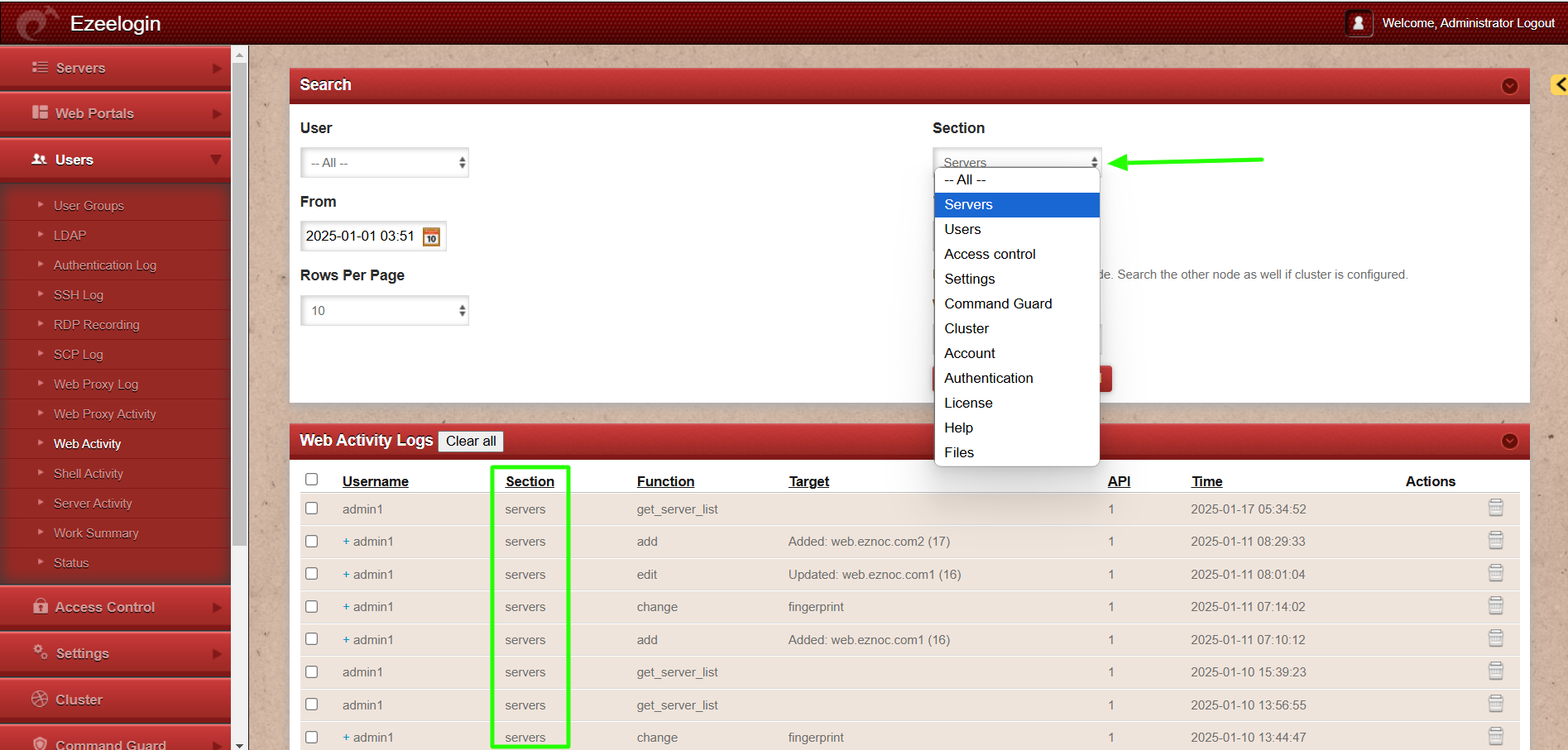Add / update / delete servers through ezeelogin API
How to add/delete/update servers in GUI using API?


root@gateway:~# php /usr/local/ezlogin/ezwapi.php [params...]
For Help
root@gateway:~# php /usr/local/ezlogin/ezwapi.php -help
Usage:
ezwapi.php -help <action>
action : API action (add_server/update_server/remove_server/reset_fingerprint/add_user_server_acl)
1. Add Server
root@gateway:~# php /usr/local/ezlogin/ezwapi.php -help add_server
Usage:
ezwapi.php add_server -api_url <API URL> -secret <API secret> -name <hostname> -description <description> -password <password> -ip_address <IP address> -group <group> [-ssh_port <port>] [-ssh_user <username>] [-keep_password <Y/N/S>]
[-enable_ssh <Y/N/H>] [-cp <control panel>]
-api_url : The API URL
-secret : The API secret configured in web panel settings
-name : The server host name
-description : A description for the server
-password : The server password
-ssh_key : The SSH private key file (optional)
-passphrase : The SSH key pass phrase (optional)
-ip_address : The server IP address
-ssh_port : The server SSH port (optional, use default if unspecified)
-ssh_user : The server SSH user (optional, use default if unspecified)
-switch_user : Switch to this user after login as SSH user (optional)
-switch_pass : Password for switch user (optional)
-switch_sudo : Y or N or E to escalate privilege with ’sudo su’ or ’enable’ (for Cisco devices) (optional, default: N = disabled)
-prompt1 : Unique string in shell prompt of SSH user (optional)
-prompt2 : Unique string in password prompt for su or sudo (optional, default: Password:)
-prompt3 : Unique string in shell prompt of root user (optional, required for sudo)
-group : The server group name
-keep_password : Y (keep given password), N (automatic) or S (keep server password as such - no verification) (optional, default: Y)
-enable_ssh : Y, N or H to enable/disable/via Host Node (optional, default: N)
-ishn : Y or N to make this a Host Node or not (optional, default: N)
-onhost : The name of Host Node (optional, default: N)
-cp : The control panel name (optional, use default if unspecified)
-dc : The datacenter name (optional, use default if unspecified)
-rc_host : The remote console host (optional)
-rc_user : The remote console user (optional)
-rc_pass : The remote console password (optional)
Step 1(a): The below example shows how to add a Server in GUI with the remote ssh user as ’root’
root@gateway:~# php /usr/local/ezlogin/ezwapi.php add_server -api_url http://10.11.1.137/ezlogin -secret 'zjdfji@#$!' -name test.noc.com -description desctest -ssh_user root -password test123 -ip_address 10.11.1.138 -group test -enable_ssh Y -keep_password S
Special characters password can be saved using API with single quotes.
eg: -password ’??r&5Q*gyKc6nGAE()’
Step 1(b): The example below shows how to add a server in GUI when the remote ssh user is non-privileged user ’admin’
How will I find the prompts for the ssh_user?
1. To find prompt1 ssh as the user directly into the server. The prompts may vary depending on the remote OS in use.
- For Centos 5,6,7
[admin@skunk ~]$ cd /home
Here prompt1 is "]$ "
- For Ubuntu 14,16 ,18
admin@ubu-nscd:~$ cd /home
Here the prompt1 is "~$ "
2. To find prompt2, simply run su - as a non root user.
[admin@skunk home]$ su -
Password:
Here prompt2 will be "ssword: "
3. The prompt 3 would be how the root prompt looks like
[root@skunk home]#
Above the unique characters that is permanent are "ot@sk" or "root@" etc.
2. Update Server
root@gateway:~# php /usr/local/ezlogin/ezwapi.php -help update_server
Usage:
ezwapi.php update_server -api_url <API URL> -secret <API secret> -name <hostname> [-newname <new hostname>] [-password <password>] [-ip_address <IP address>] [-ssh_port <port>] [-ssh_user <username>]
[-group <group>] [-keep_password <Y/N/S>] [-enable_ssh <Y/N>] [-cp <control panel>]
-api_url : The API URL
-secret : The API secret configured in web panel settings
-name : The server host name
-newname : The new host name (optional)
-description : A description for the server
-password : The server password (optional)
-ssh_key : The SSH private key file (optional)
-passphrase : The SSH key pass phrase (optional)
-ip_address : The server IP address (optional)
-ssh_port : The server SSH port (optional)
-ssh_user : The server SSH user (optional)
-switch_user : Switch to this user after login as SSH user (optional)
-switch_pass : Password for switch user (optional)
-switch_sudo : Y or N or E to escalate privilege with ’sudo su’ or ’enable’ (for Cisco devices) (optional, default: N = disabled)
-prompt1 : Unique string in shell prompt of SSH user (optional)
-prompt2 : Unique string in password prompt for su or sudo (optional)
-prompt3 : Unique string in shell prompt of root user (optional, required for sudo)
-rdp_port : The server RDP port (optional, use default if unspecified)
-group : The server group name
-keep_password : Y (keep given password), N (automatic) or S (keep server password as such - no verification) (optional)
-enable_ssh : Y, N or H to enable/disable/via Host Node (optional)
-ishn : Y or N to make this a Host Node or not (optional)
-onhost : The name of Host Node (optional)
-cp : The control panel name (optional)
-dc : The datacenter name (optional)
-rc_host : The remote console host (optional)
-rc_user : The remote console user (optional)
-rc_pass : The remote console password (optional)
Step 2(a): Refer below example to update the server
root@gateway:~# php /usr/local/ezlogin/ezwapi.php update_server -api_url http://10.11.1.137/ezlogin -secret 'zjdfji@#$!' -name ez.test.com -description desctest -password test123 -ip_address 10.11.1.138 -group test -ssh_port 22 -rdp_port 3389
3. Delete Server
root@gateway:~# php /usr/local/ezlogin/ezwapi.php -help remove_server
Usage:
ezwapi.php remove_server -api_url <API URL> -secret <API secret> -name <hostname>
-api_url : The API URL
-secret : The API secret configured in web panel settings
-name : The server host name
Step 3(a) Refer below example to delete a server
root@gateway:~# php /usr/local/ezlogin/ezwapi.php remove_server -api_url http://10.11.1.137/ezlogin -secret 'zjdfji@#$!' -name ez.test.com
root@gateway:~# php /usr/local/ezlogin/ezwapi.php -help list_servers
Usage:
ezwapi.php list_servers -api_url <API URL> -secret <API secret>
-api_url : The API URL
-secret : The API secret configured in web panel settings
root@gateway:~# php /usr/local/ezlogin/ezwapi.php list_servers -api_url http://192.168.1.38/ezlogin -secret 'zjdfji@#$!'
200: {"status":"success","extra":[{"id":"3","name":"db.eznoc.com"},{"id":"16","name":"Log.eznoc.com"},{"id":"17","name":"Production server"},{"id":"10","name":"Windows Server"}]}
Listing servers via API is only available from Ezeelogin version 7.40.0
root@gateway:~# php /usr/local/ezlogin/ezwapi.php -help reset_fingerprint
Usage:
ezwapi.php reset_fingerprint -api_url <API URL> -secret <API secret> -name <hostname>
-api_url : The API URL
-secret : The API secret configured in web panel settings
-name : The server host name
Step 5(a): Refer below example to reset fingerprint for a remote server
root@gateway:~# php /usr/local/ezlogin/ezwapi.php reset_fingerprint -api_url http://192.168.29.4/ezlogin -secret 123456 -name Cent-database.hu
6. User-server access control
root@gateway:~# php /usr/local/ezlogin/ezwapi.php -help add_user_server_acl
Usage:
ezwapi.php add_user_server_acl -api_url <API URL> -secret <API secret> -user <username> -server <hostname> [-defer]
-api_url : The API URL
-secret : The API secret configured in web panel settings
-user : The username
-server : The server host name
-defer : Defer the ACL addition if user doesn’t already exist (optional)
Step 6(a) Refer below example for user-server access control
root@gateway:~# php /usr/local/ezlogin/ezwapi.php add_user_server_acl -api_url http://192.168.1.9/ezlogin -secret zxcvbnm -user victor -server centos.server
- Make sure API is enabled in API settings for the API script to work.
- If you need to execute the API script from a server other than the Ezeelogin installed server(jump server), copy /usr/local/ezlogin/ezwapi.php and /usr/local/ezlogin/apilib file to the server which you want to execute. PHP should be installed on the server.
View API logs
Step 1(A): To view all the actions performed via API navigate to Users -> Web Activity -> who and select API. This will display a list of logs for all the actions executed through API.

Step 1(B): From the drop-down menu for the section, select "Servers" which will display the list of logs for all the server actions performed via API.

This feature to list the logs for the actions performed via API is available from Ezeelogin version 7.40.0